Pakistani nationalism
This article has multiple issues. Please help improve it or discuss these issues on the talk page. (Learn how and when to remove these messages)
|
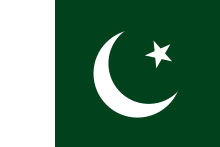
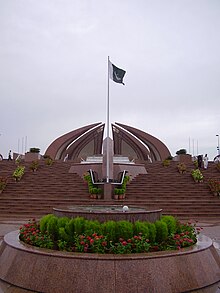
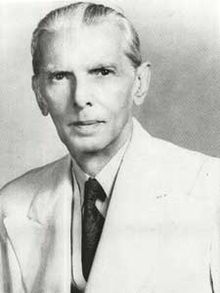
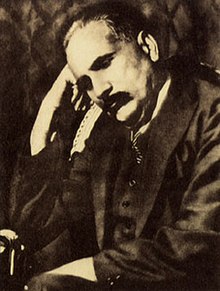
Pakistani nationalism refers to the political, cultural, linguistic, historical, [commonly] religious and geographical expression of patriotism by the people of Pakistan, of pride in the history, heritage and identity of Pakistan, and visions for its future.
Unlike the secular nationalism of most other countries, Pakistani nationalism and the religion of Islam have often not been mutually exclusive and religion is often a part of the Pakistani nationalist narrative.
From a political point of view and in the years leading up to the independence of Pakistan, the particular political and ideological foundations for the actions of the Muslim League can be called a Pakistani nationalist ideology. It is a singular combination of philosophical, nationalistic, cultural and religious elements.
Most of modern-day Pakistani nationalism is centered on the common Indo-Iranian identity and heritage of 99% of the population. Baloch, Kashmiris, Mohajirs, Punjabis, Pakhtuns and Sindhis and minorities are mainly of Indo-Iranian stock. It also refers to the consciousness and expression of religious influences that help mould the national consciousness. Nationalism describes the many underlying forces that moulded the Pakistan movement, and strongly continue to influence the politics of Pakistan.
National consciousness in Pakistan
Muslim conquest of Indian Subcontinent
According to Pakistan Studies curriculum, Muhammad bin Qasim is often referred to as the first Pakistani.[1] Muhammad Ali Jinnah also acclaimed the Pakistan movement to have started when the first Muslim put a foot in the Gateway of Islam.[2]
Some Pakistani nationalists state that Pakistan is the successor state of Islamic empires and kingdoms that ruled the region for almost a combined period of one millennium, the empires and kingdoms in order are Abbasid, Ghaznavid Empire, Ghorid Kingdom, Delhi Sultanate and Mughal Empire. Pakistan's imperial past composes possibly the largest segment of Pakistani nationalism. Some less popular views include the introduction of Azizism[3] into the political system.
Renaissance vision
See also: Syed Ahmed Khan, Indian rebellion of 1857

Syed Ahmed Khan promoted Western-style education in Muslim society, seeking to uplift Muslims economically and politically in British India. He founded the Aligarh Muslim University, then called the Anglo-Oriental College.
In 1835 Lord Macaulay's minute recommending that Western rather than Oriental learning predominate in the East India Company's education policy had led to numerous changes. In place of Arabic and Persian, the Western languages, history and philosophy were taught at state-funded schools and universities whilst religious education was barred. English became not only the medium of instruction but also the official language in 1835 in place of Persian, disadvantaging those who had built their careers around the latter language. Traditional Islamic studies were no longer supported by the state, and some madrasahs lost their waqf or endowment. The Indian rebellion of 1857 is held by nationalists[who?] to have ended in disaster for the Muslims, as Bahadur Shah Zafar, the last Mughal, was deposed. Power over the subcontinent was passed from the East India Company to the British Crown. The removal of the last symbol of continuity with the Mughal period spawned a negative attitude amongst some Muslims[who?] towards everything modern and western, and a disinclination to make use of the opportunities available under the new regime.
Seeing this atmosphere of despair and despondency, Syed launched his attempts to revive the spirit of progress within the Muslim community of India. He was convinced that the Muslims, in their attempt to regenerate themselves, had failed to realise that mankind had entered a very important phase of its existence, i.e., an era of science and learning. He knew that the realisation of that was the source of progress and prosperity for the British. Therefore, modern education became the pivot of his movement for regeneration of the Indian Muslims. He tried to transform the Muslim outlook from a mediaeval one to a modern one.
Syed's first and foremost objective was to acquaint the British with the Indian mind; his next goal was to open the minds of his countrymen to European literature, science and technology.
Therefore, in order to attain these goals, Syed launched the Aligarh Movement, of which Aligarh was the center. He had two immediate objectives in mind: to remove the state of misunderstanding and tension between the Muslims and the new British government, and to induce them to go after the opportunities available under the new regime without deviating in any way from the fundamentals of their faith.[citation needed]
At the same time, Muslim nationalist leaders like Muhammad Iqbal emphasized the spiritual richness of Islam and Islamic philosophy. Muhammad Iqbal, the conceptual founder of Pakistan, is venerated by Pakistani and Muslim nationalists[who?] for implicitly endorsing the independence of a Muslim state in South Asia. Initially, Iqbal did not voice any such views. It was only in the late 1920s and early 1930s that he started proposing for autonomy for Muslim provinces within India. At this time, the Muslim League was not demanding independence from the British unlike the Indian National Congress. Iqbal demanded a Muslim state, regardless of whether it would have self-government, or whether it would be within the British Empire.[4]
Iqbal is widely credited[by whom?] for his work in encouraging the political rejuvenation and empowerment of Muslims, and as a poet not only in India and Pakistan, but also in Iran and Muslim nations in the Middle East.
Independence of Pakistan
In the Indian rebellion of 1857, Muslim soldiers and regional kings fought the forces allied with the British Empire in different parts of the British Raj. The war's spark arose because the British attacked the "Beastly customs of Indians" by forcing the South Asian soldiers to handle Enfield P-53 gun cartridges greased with lard taken from slaughtered pigs and tallow taken from slaughtered cows. The cartridges had to bitten open to use the gunpowder, effectively meaning that sepoys would have to bite the lard and tallow. This was a manifestation of the disregard that the British exhibited to Muslim and Hindu religious traditions, such as the rejection of Pork in Islam, the rejection of slaughter of cow in Hinduism and the mandate of vegetarianism in Hinduism. There were also some kingdoms and peoples who supported the British. This event laid the foundation not only for a nationwide expression, but also future nationalism and conflict on religious and ethnic terms.
The Muslim desire for independence and a new state for the Indian Muslims, or Azadi was born with Kernal Sher Khan, who looked to Muslim history and heritage, and condemned the fact Muslims were ruled by the British Empire and not by Muslim leaders. The idea of complete independence did not catch on until after World War I, when the British reduced civil liberties with the Rowlatt Acts of 1919. When the Jallianwala Bagh Massacre in Amritsar, Punjab (India) of hundreds of unarmed civilians by British forces took place in the same year, the Muslim public was outraged and most of the Muslim political leaders turned against the British. Pakistan was finally gained independence in 1947 on the basis of Two Nation Theory.Today, Pakistan is divided into 4 provinces. The last census recorded the 1981 population at 84.3 million, nearly double the 1961 figure of 42.9 million. By 1983, the population had tripled to nearly 93 million, making Pakistan the world's 9th most populous country, although in area it ranked 34th.[5]
Pakistani nationalist symbols

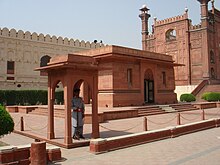
Because of the country's identity with Islam, mosques like Badshahi Mosque and Faisal Mosque are also used as national symbols either to represent "glorious past" or modernistic future. Pakistan has many shrines, sights, sounds and symbols that have significance to Pakistani nationalists. These include the Shrines of Political leaders of pre-independence and post-independence Pakistan, Shrines of Religious leaders and Saints, The Shrines of Imperial leaders of various Islamic Empires and Dynasties, as well as national symbols of Pakistan. Some of these shrines, sights and symbols have become a places of Pilgrimage for Pakistani ultra-nationalism and militarism, as well as for obviously religious purposes.
The older ten rupee notes of the Pakistani rupee included background images of the remains of Mohenjo-daro and Harappa.
Nationalism and politics
The political identity of the Pakistani Armed Forces, Pakistan's largest institution and one which controlled the government for over half the history of modern-day Pakistan and still does, is reliant on the connection to Pakistan's Imperial past. The Pakistan Muslim League's fortunes up till the 1970s were propelled by its legacy as the flagship of Pakistan's Independence Movement, and the core platform of the party today evokes that past, considering itself to be the guardian of Pakistan's freedom, democracy and unity as well as religion. Other parties have arisen, such as Pakistan Peoples Party, once advocating a leftist program and now more centrist. Nationally, the ruling Pakistan Peoples Party (PPP) is weak.[6]In contrast, the Muttahida Majlis-e-Amal employs a more aggressively theocratic nationalistic expression. The MMA seeks to defend the culture and heritage of Pakistan and the majority of its people, the Muslim population. It ties theocratic nationalism with the aggressive defence of Pakistan's borders and interests against archrival India, with the defence of the majority's right to be a majority.
Ethnic nationalist parties include the Awami National Party, which is closely identified with the creation of a Pashtun-majority state in North-West Frontier Province and the Federally Administered Tribal Areas includes many Pashtun leaders in its organization. However, the Awami National Party, At the last legislative elections, 20 October 2002, won a meagre 1.0% of the popular vote and no seats in the lower house of Parliament. In Balochistan, the Balochistan National Party[disambiguation needed] uses the legacy of the independent Balochistan to stir up support, However at the legislative elections, 20 October 2002, the party won only 0.2% of the popular vote and 1 out of 272 elected members.
Almost every Pakistani state has a regional party devoted solely to the culture of the native people. Unlike the Awami National party and the Balochistan national party, these mostly cannot be called nationalist, as they use regionalism as a strategy to garner votes, building on the frustration of common people with official status and the centralization of government institutions in Pakistan. However, the recent elections as well as history have shown that such ethnic nationalist parties rarely win more than 1% of the popular vote, with the overwhelming majority of votes going to large and established political parties that pursue a national agenda as opposed to regionalism.
Internal factions
During the late years of British rule and leading up to independence, Muslim nationalism in South Asia had three groups of supporters:
1) Idealists, such as majority of Muslim students and intellectuals, inspired by Aligarh movement and Allama Iqbal, driven by a fear of "false secularism" that would assimilate their beliefs, culture and heritage and Islamic ideology into a common system that defied Islamic civic tenets and ideals while hoping to create a state where their higher education, reformist Islamist ideology and wealth would keep them in power over the other Muslims of India.
2) Realists, driven by political inflexibility demonstrated by the Indian National Congress, feared a systematic disenfranchisement of Muslims. This also included many members of the Parsi, and Nizari Ismaili communities.
3) Traditionalists, primarily lower Orthodoxy (Barelvi), that feared the dominative power of the upper Orthodoxy (Deobandi) and saw Pakistan as a safe haven to prevent their domination by State-controlled propaganda. However leaders of upper Orthodoxy such as Shabbir Ahmad Usmani and Ashraf Ali Thanwi also supported the state of Pakistan in the interest of an Islamic Republic.
Nuclear power
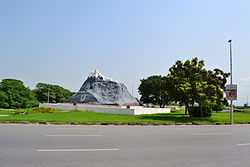
The intense guerrilla war in far Eastern Pakistan, followed by India's successful intervention led to the secession of Eastern contingent as Bangladesh. The outcomes of the war played a crucial role in the civil society. In January 1972, a clandestine crash programme and a spin-off to literary and the scientific revolution as response to that crash programme led Pakistan becoming the nuclear power.
First public tests were experimented out in 1998 (code names:Chagai-I and Chagai-II) in a direct response to India's nuclear explosions in the same year; thus Pakistan became the 7th nation in the world to have successfully developed the programme. It is postulated that Pakistan's crash programme arose in 1970 and mass acceleration took place following the India's nuclear test in 1974. It also resulted in Pakistan pursuing similar ambitions, resulting in the May 1998 testings of five nuclear devices by India and six as a response by Pakistan, opening a new era in their rivalry. Pakistan, along with Israel and India, is three of the original states that have restrained itself from being party of the NPT and CTBT which it considers an encroachment on its right to defend itself. To date, Pakistan is the only Muslim nuclear state.
Pakistani nationalist songs
Pakistani singers such as Masood Rana, Mehdi Hassan, Asad Amanat Ali Khan, Alamgir, Benjamin Sisters and Pakistani bands such as Vital Signs and Junoon popularized Pakistani nationalism with songs such as Millat Ka Paasbaan (Masood Rana), Ye Watan Tumhara Hai (Mehdi Hassan), Ai Watan Pyare Watan (Asad Amanat Ali Khan), Khayal Rakhna (Alamgir and Benjamin Sisters), Dil Dil Pakistan (Vital Signs) and Jazba-e-Junoon (Junoon).
Pakistani nationalist blogs
A recent trend in Pakistani nationalism are Pakistani nationalist blogs such as The Pakistani Nationalist,[7] PakNationalists[8] and PKKH.[9]
See also
References
- ^ "History books contain major distortions". Daily Times.
- ^ "Pakistan Movement". cybercity-online.net.
- ^ "Azizism". Pastebin.com.
- ^ http://www.allamaiqbal.com/person/biography/biotxtread.html
- ^ Newcomb, L (1986). "The Islamic Republic of Pakistan: Country profile". International demographics. 5 (7): 1–8. PMID 12314371.
- ^ https://www.economist.com/news/asia/21576668-after-14-years-exile-and-opposition-nawaz-sharif-expects-win-third-spell-prime?zid=309&ah=80dcf288b8561b012f603b9fd9577f0e[full citation needed]
- ^ The Pakistani Nationalist,
- ^ PakNationalists
- ^ PKKH
Further reading
- Sanjay Chaturvedi (May 2002). "Process of Othering in the case of India and Pakistan". Tijdschrift voor Economische en Sociale Geografie. 93 (2): 149. doi:10.1111/1467-9663.00191.
- Selig S. Harrison (December 1997). "The United States and South Asia: Trapped by the Past?". Current History. Current History, Inc.
- Iftikhar H. Malik (July 1996). "The State and Civil Society in Pakistan: From Crisis to Crisis". Asian Survey. 36 (7): 673–690. doi:10.1525/as.1996.36.7.01p0149s.
- Moonis Ahmar (October 1996). "Ethnicity and State Power in Pakistan: The Karachi Crisis". Asian Survey. 36 (10): 1031–1048. doi:10.1525/as.1996.36.10.01p0176y.
- Malik, Hafeez (1961). "The Growth of Pakistani Nationalism, 800 AD – 1947 AD". Syracuse, New York: Syracuse University.
{{cite journal}}: Cite journal requires|journal=(help) - MH Khatana. "Foundations of Pakistani Nationalism: The Life and Times of Allama Iqbal". Prof. Dr. S. Razi Wasti's Collection, GC University Libraries, Lahore.
- Feroz Ahmed (December 1971). "Why Pakistan's Unity Was Jeopardized?". Pakistan Forum. 2 (3): 4–6. doi:10.2307/2569081. JSTOR 2569081.
- Anwar H. Syed (Summer 1980). "The Idea of a Pakistani Nationhood". Polity. 12 (4): 575–597. doi:10.2307/3234301. JSTOR 3234301.
- Saadia Toor (September 2005). "A national culture for Pakistan: the political economy of a debate". Inter-Asia Cultural Studies. 6 (3). Routledge: 318–340. doi:10.1080/14649370500169946.
